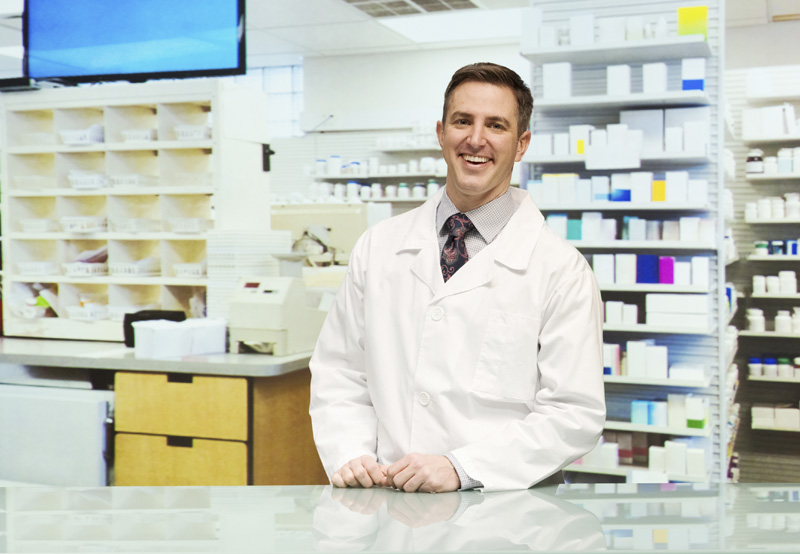What to Know About a Career in Pharmacy

With the recent growth in the pharmaceutical industry and its ability to research diseases and create new medications, the role of a pharmacist is two-fold.
First, pharmacists must dispense medications prescribed to patients by doctors. However, in order to do an accurate job, they must also understand as much as possible about new, upcoming medications, including how these prescriptions might interact with other drugs the patient is already on. And second, the pharmacist must act as an intermediary between the patient and doctor, and is and important line of defense in making sure patients aren’t exposed to harmful drug interactions.
Working as a Pharmacist
Typically, pharmacists visit with their patients every time they come in, in order to answer any questions and to reassure the patient. Consequently, it’s important that you, as a pharmacist, fully comprehend all the counter-indications and side effects of the medications you prescribe, so that you’re able to answer patient questions. And since pharmacists usually see their patients on a monthly basis, it’s also important that they also keep an eye out for any possible problems or side effects the patient’s doctor may have missed. Because of this, it’s vital that pharmacists also touch base with the doctors from time to time to make sure that the medications are working properly.
Pharmacists act as an intermediary between patients and doctors.
The other side of the pharmacist’s job duties is that they’ll responsible for counting out the medications and dispensing them. Attention to detail in this area is crucial, since a mistake in a patient’s prescription or dosage could mean serious injury or death. In addition, pharmacists also need to keep an accurate record of the medications they’ve dispensed and the remaining inventory in the pharmacy. Most pharmacists will use a computer database to keep detailed patient records so that they’ll have access to details on the medicine given to any patient at their pharmacy, so you’ll need to have some skills with computers and data entry as well.
Unlike most professional jobs, pharmacists may have a far different schedule than the typical nine to five workday. Many pharmacies are open for extended hours – or even twenty four hours a day – to make sure that patients have easy access to their medications, no matter what their personal schedules are. However, the downside of this is that many pharmacists will be required to work odd hours. Usually, you’ll find the long, odd hours more common for junior pharmacists in chain pharmacies. If you’re working in a small, rural community, you may find your work hours to be closer to the standard workday.
If you aren’t sure about working full-time, look for pharmacies that also hire replacement or temporary pharmacists. These are licensed pharmacists who may work shorter hours, or split their time between a few different pharmacies. This is especially common in rural areas where there may be only one or two registered pharmacists. If one of them wanted to take a vacation, the pharmacy would call on the revolving pharmacist to come in and take over their job duties for a period of time. This can be a great opportunity for pharmacists who don’t want to work full-time, as well as for the pharmacies that are too small to invest in more than one pharmacist.
How to Become a Pharmacist
Pharmacists are no longer seen merely as people who count and dispense medications – but rather, they have grown into an integral part of the patient’s treatment process.
Since many people now see more than one doctor or specialist, the risk of contradicting medications and prescriptions has skyrocketed, although the doctors dispensing the medications might never realize this. However, as it is the pharmacist who dispenses the medications, they will be relied upon to catch something that the doctor may have missed.
Training and Education for Pharmacists
In addition, if a patient has questions or concerns about any medications they’re on, they’ll often bring this issue up with their pharmacists instead of their regular physicians. This increasing amount of patient interaction means that pharmacists today have to have a more in-depth education and training experience before they’re ready to practice. Consequently, colleges have moved away from the standard bachelor’s of pharmacy degree in order to provide a more comprehensive education for future pharmacists.
Pharmacists are responsible for dispensing medicines.
Now, students are required to go through a more difficult program known as the Pharm.D. degree before they are allowed to become practicing pharmacists. The colleges who award this degree are governed by the Accreditation Council for Pharmacy Education (ACPE), which provides specific guidelines about which classes students must take before registering for the Pharmacy College Admissions Test (PCAT) and being admitted to a Pharm.D. program.
This newer degree combines aspects of the standard sciences associated with the old pharmacy degree with the more social side of the occupation through courses in the humanities and social sciences, since in today’s world, a pharmacist who can’t effectively communicate with their clients can’t be utilized to their full potential.
Those pharmacists who are looking to get into either the academic field or research pharmacology will have to continue their education with either a master’s of science or a Ph.D. in pharmacy, following completion of the Pharm.D. degree. These programs will likely have their own admissions process, so it’s important to check and see what each one requires of its applicants.
Upon completing the Pharm.D. degree, prospective pharmacists will then have to pass licensing exams administered by the National Association of Boards of Pharmacy (NABP). One of these tests – the North American Pharmacist Licensure Exam (NAPLEX) – is required in all fifty states. The other test, however, is only required in forty-four of the fifty states as is called the Multistate Pharmacy Jurisprudence Exam (MPJE). After a pharmacist has been certified to practice in the United States, every state except California will allow them to use their previously granted credentials.
After receiving his or her license, a pharmacist will have to take continuing education classes in order to renew their certification every year. These courses are intended to keep pharmacists up-to-date on the latest prescriptions and drug therapies. As the patient’s first line of defense against contraindicated drugs, a pharmacist must be knowledgeable about the effects of both new and existing pharmaceuticals – which is especially important given the rapid rate at which pharmaceutical companies are releasing new medicines.



